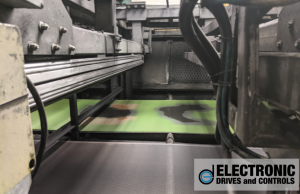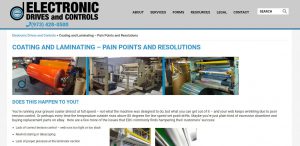[vc_row 0=””][vc_column 0=””][vc_single_image image=”2908″ img_size=”full”][/vc_column][/vc_row][vc_row][vc_column][vc_column_text]
A major metals processor in the Midwest faced a significant challenge in modernizing its tin plating line to enhance productivity, consistency, and operational efficiency. Confronted with the complexities of integrating advanced automation, maintaining consistent product quality, and adapting to a newly relocated plant environment, they turned to Electronic Drives and Controls (EDC) for a custom solution. Using Siemens S120 drives, Fisher Scope X-Ray technology, and custom-engineered edge guide systems, EDC delivered a solution that improved line speed, product quality, and operational safety.[/vc_column_text][/vc_column][/vc_row][vc_row][vc_column][vc_column_text]
Introduction
[/vc_column_text][/vc_column][/vc_row][vc_row][vc_column][vc_column_text]
Tin plating is a critical process in the metals industry, most commonly used to enhance the corrosion resistance, conductivity, and overall durability of metal products. At a high level, tin plating involves applying a thin layer of tin to a metal substrate—often steel or copper—through an electrochemical process. This protective coating not only improves the metal’s appearance but also enhances its solderability and resistance to oxidation. In industrial applications, consistent tin thickness is crucial, as even minor variations can significantly impact product performance and end user satisfaction.EDC’s client on this project is a major multinational metals company known for its high-quality metals products. To remain competitive and to address operational challenges, they sought to upgrade one of its tin plating lines. The project’s primary objectives were to replace operator-dependent processes with automated systems that could consistently control tension, line speed, and tin thickness—key variables that directly impact product quality and throughput. Additionally, the relocation of the line to a different plant added complexity, requiring a solution that could adapt to changes in layout, wiring conditions, and equipment positioning in order to minimize downtime.
Line Overview: The line begins with an Uncoiler, which feeds a metal strip through a wiper pad and then into a series of hydrochloric acid and flux baths. After each bath, the strip is wiped to remove excess fluid. From there, the strip passes through a Bridle that helps maintain tension before entering a molten tin bath, where plating occurs. As the strip exits the tin bath, high-velocity air wipes remove excess tin and ensure a consistent coating. The positioning of these air wipes is critical, as even slight misalignment can lead to variation in tin thickness. Two edge guides—one before the tin bath and another before the Recoiler—help ensure that the strip stays properly aligned. A second Bridle is positioned after the vertical tower, just before the Recoiler, which winds the finished strip for downstream handling.
[/vc_column_text][/vc_column][/vc_row][vc_row][vc_column][vc_column_text]
Problem
[/vc_column_text][/vc_column][/vc_row][vc_row][vc_column][vc_column_text]
Operational Inconsistency and Operator Dependency
The existing system relied heavily on manual adjustments by operators, which led to variability in product quality and throughput. This challenge was further compounded by staffing concerns. With experienced operators nearing retirement age, it was difficult to find reliable replacements to perform the nuanced manual processes required to operate the line’s equipment successfully.[/vc_column_text][/vc_column][/vc_row][vc_row][vc_column][vc_column_text]
Complexity of Relocation
The project involved reconfiguring and relocating the tin plating line to a different plant, introducing significant rework not typically required for a basic line upgrade. The move led to alignment and wiring challenges that required recalibration and troubleshooting. EDC also had to account for differences in power distribution, control panel placement, and new Uncoiler and Recoiler sections—all of which affected how the system needed to be configured and integrated in the new space.[/vc_column_text][/vc_column][/vc_row][vc_row][vc_column][vc_column_text]
Tight Scheduling Constraints
The project was executed under strict scheduling constraints. EDC created a strategic plan to sequence the installation and commissioning phases. This minimized downtime and kept the project on track, ensuring the line would be operational according to the required timeline.[/vc_column_text][/vc_column][/vc_row][vc_row][vc_column][vc_column_text]
Safety and Environmental Challenges
The production environment introduced its own hazards, including hydrochloric acid (HCL) baths that created a highly corrosive atmosphere. These conditions posed risks to both equipment and personnel, prompting the use of advanced safety controls such as interlocks, fail-safe relays, and physical barriers to protect workers and meet industry safety requirements.[/vc_column_text][/vc_column][/vc_row][vc_row][vc_column][vc_column_text]
Solutions Implemented
[/vc_column_text][/vc_column][/vc_row][vc_row][vc_column][vc_column_text]To overcome the complex challenges posed by the tin plating line project, EDC implemented a series of advanced automation solutions tailored to this clients’ unique operational requirements. These solutions not only addressed the immediate issues of operational inconsistency, safety, and relocation but also laid the groundwork for scalable and adaptable production capabilities into the future.[/vc_column_text][/vc_column][/vc_row][vc_row][vc_column][vc_column_text]
Smart Automation with Real-Time Monitoring
At the heart of the modernization effort was the integration of advanced Siemens drive technology and intelligent visualization systems. This architecture provided precise, flexible control of line speed, tension, and tin thickness.
One of the most advanced features of the project was the addition of the Fisher Scope X-Ray. Previously, operators would manually measure and adjust tin thickness—a process prone to delays and human error. The new system continuously monitors the coating thickness and communicates directly with the HMI to maintain optimal output in real time—removing the need for operator intervention and significantly improving consistency.
Installed Components:
- Siemens SINAMICS S120 Drive System
- Siemens CU320-2 PN Control Unit
- Siemens SIMATIC HMI TP1200 Comfort Panel – 12″ widescreen with Profinet interface, designed for high-performance visualization applications
- Fisher Scope X-Ray – for continuous tin thickness monitoring and automatic adjustment
[/vc_column_text][/vc_column][/vc_row][vc_row][vc_column][vc_column_text]
Edge Guide Control and Tension Management
Maintaining strip alignment and tension was a key challenge, especially after this client replaced the existing Uncoiler with a heavier, hydraulic model from storage to accommodate larger coils. This modification required changes to the control system to ensure consistent material handling and stable process control. EDC developed a custom edge guide system using light bar-type sensors and actuators to maintain precise strip positioning throughout the process—from the Uncoiler, through the Bridles, and on to the Recoiler. Together, these systems ensured repeatable tension control and reduced unplanned maintenance.
Installed Components:
- Edge Sensor (model DSE-41)
- Edge Guide Actuator (model GMA-D1-5-100.1-ISCT-A)
- Programmable Oscillators
Self-contained Edge Guide Controllers - Hydraulic Uncoiler
[/vc_column_text][/vc_column][/vc_row][vc_row][vc_column][vc_column_text]
Advanced Drive and Motor Integration
Marathon AC vector motors and Siemens drives were used to power key sections of the line, including the Bridles and Recoiler. This setup delivered improved speed control, synchronization, and system reliability while reducing maintenance demands.
Installed Components:
- Marathon AC Vector Motors with Encoder Feedback
- Siemens SINAMICS S120 Drive System
[/vc_column_text][/vc_column][/vc_row][vc_row][vc_column][vc_column_text]
Enhanced Safety and Risk Management
Operating near hydrochloric acid (HCL) baths introduced corrosive and hazardous conditions. To protect personnel and equipment, EDC implemented a layered safety architecture including light curtains, load cells, emergency stop stations, and a dual-channel safety relay—all tied into the Siemens control system for real-time monitoring and safe stopping.
The team also conducted risk assessments throughout the project, enabling them to plan proactively for issues and keep the installation on track despite relocation complexities.
Installed Components:
- Light Curtains
- Load Cells
- Safety E-Stop Relay
- E-Stop Stations and Reset Button
[/vc_column_text][/vc_column][/vc_row][vc_row][vc_column][vc_column_text]
Outcomes and Results
[/vc_column_text][/vc_column][/vc_row][vc_row][vc_column][vc_column_text]
The solutions implemented on the tin plating line are designed to deliver significant operational improvements. Based on the scope of work and strategic upgrades, the expected results include:- Enhanced Product Quality: With real-time monitoring and automated adjustments via the Fisher Scope X-Ray, the tin plating process is expected to achieve highly consistent thickness across the entire strip. This will minimize material waste and ensure compliance with stringent customer specifications.
- Increased Productivity and Efficiency: The integration of Siemens S120 drives and smart automation reduces reliance on manual operator adjustments, enabling a more streamlined and repeatable process. This is anticipated to result in higher throughput and decreased production downtime.
- Improved Tension Control and Material Handling: The upgraded edge guide control system and programmable controls ensure better strip alignment, reducing defects and preventing operational inconsistencies that previously led to production delays.
- Operational Safety Enhancements: The introduction of dual-channel safety circuits, light curtains, and load cells mitigates risks associated with the hostile HCL acid bath environment. These safety improvements contribute to a safer working environment for plant operators.
- Adaptability for Future Expansion: The system’s modular design and ability to accommodate auxiliary equipment modifications mean the processor can scale operations or make further refinements without major overhauls. If successful, similar technology may be utilized on other tin plating lines within the client’s operations.
[/vc_column_text][/vc_column][/vc_row][vc_row][vc_column][vc_column_text]
Lessons Learned and Future Outlook:
[/vc_column_text][/vc_column][/vc_row][vc_row][vc_column][vc_column_text]
The tin plating line project required EDC to remain flexible and hands-on throughout. From troubleshooting wiring and alignment issues after relocating the line, to adjusting control logic to accommodate new equipment added by the client mid-project, the team adapted quickly to keep the installation moving forward, ensuring that new components were incorporated with minimal turn-around time.Close collaboration, proactive communication, and contingency planning also played critical roles. When client-side delays arose, EDC maintained progress by working on parallel tasks, providing remote support and adjusting timelines to keep the project moving forward without compromising its long-term objectives.
The improvements made through this modernization are expected to deliver measurable gains in product quality, efficiency, and safety. Using state-of-the-art Siemens technology and advanced control systems, EDC provided this client with a scalable solution that positions their tin plating operation for continued success. The approach taken in this project will also serve as a model for similar upgrades across other lines within this metal processor’s operations.[/vc_column_text][/vc_column][/vc_row]



